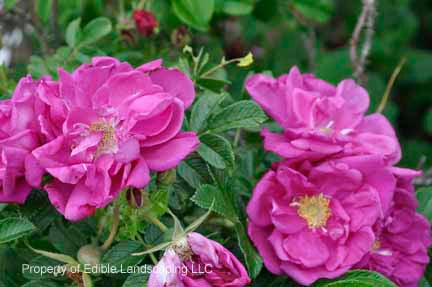
Rosa rugosa hyb.
Purple Pavement Rose is also known as Rotsmere in Germany. It is a carefree dwarf rose. Healthy repeat blooms start a week later than Foxy Pavement and is very fragrant. Height 3' and same width, purple pavement will spread to a 6' circle. The very hardy shrub has huge red hips in late summer and fall. Leaves do not get leaf spot. Zones 3-8
| Plant Characteristics | |
|---|---|
| Pest Resistance | Very Good |
| Disease Resistance | Very Good |
| Drought Tolerance | Very Good |
| Heat Tolerance | Good |
| Humidity Tolerance | Good |
| Sun Tolerance | Good |
| Wet Soil Tolerance | Poor |
| Shade Tolerance | Fair |
| No Spray | Very Good |
| Salt Tolerance | Good |
| Fresh for Kids | Fair |
| Deer Resistance | Fair |
| Thorns | Yes |
| Plant Type | Shrub |
| Soil Type | Adaptable |
| Edible Type | Fruit |
| Self Fertile | Yes |
| This information is accurate to the best of our knowledge, comments/opinions are always welcome | |
Due to import restrictions we are unable to ship Purple Pavement Rose to CA...
Rose Care GuideThe rose has always held a prominent place in poetry, literature, tradition, symbolism, art and world cuisine. It has led men forth in conquest, migration, colonization, war and peace. It has intrigued writers, philosophers, poets, and many others who have tried to explain its beauty.
About 75 A.D. Pliny, in his "Historia Naturalis" mentioned more than 300 remedies using rose water. Medieval ladies sprinkled rose petals among clothes, bathed in rose petal water, used rose and glycerin for beauty purposes and ate candied roses. Gerard's "herbal" (about 1600) tells us the distilled water of roses is good for the strengthening of the heart, refreshing the spirits, and likewise for all things that require a gentle cooling.
Preparation
When working with roses keep in mind:
Always wash thoroughly, but gently!
Grasp the stem in one hand and the flower in the other and pull the petals 'en masse' from the calyx. With a scissors cutoff the white heel at the base of the petals, as this part is often bitter.
The more fragrant the rose, the more flavor you'll capture. The old-fashioned varieties are the best choice, and those grown in the garden are more desirable than the greenhouse variety, as some of the new hybrids have very little fragrance, and their petals tend to be on the tough side.
Roses vary in flavor and the darker one usually has a stronger taste than the lighter shades.
RECIPES
Candied Rose Petals
Beat the white of an egg until foamy. Dip the petals into the foam, gently shake off the excess and sprinkle generously with sugar. A few drops of red food coloring may be mixed with the sugar before sprinkling the petals, so they retain their rich, rosy color.
Allow to dry thoroughly and store in an air-tight container.
In years gone by, no box of sweets was complete without a few candied rose petals tucked in. If you have miniature roses you may candy the whole flower.
Rose Hip Jam
1 quart rose hips 1Tb lemon juice
3 C water 4 C sugar
Boil the hips about 15 minutes. Stand off the heat, cover and after an hour puree by stirring through a sieve.
To 1 3/4 cups of puree add the sugar and lemon juice, stirring constantly bring to a rolling boil. Add 1/2 bottle of liquid pectin, boil 1 full minute. Remove from the heat, skim and pour into jelly glasses.
Rose vinegar
3/4 C cider vinegar 2 Tb honey 1 Tb Rose Water
Blend well and add a drop of red food coloring. Let stand an hour before using. Rose vinegar is excellent on fruit salad, cold lamb, chicken salad or lobster.
(Rose water is available at the gourmet food stores and from your druggist.)
Rose Hip Puree
Fresh rose hips put through a baby food grinder makes a red puree that is very delicious. We usually sweeten to taste.
Planting
Plant roses in spaces where there's good air circulation. Don't over fertilize with nitrogen, as this may lead to pest such as aphid.
Roses require full sun and excellent drainage. The soil can be of average quality, but it's a good idea to add a couple of spadefuls of humus and 1 cup of balanced fertilizer and the plant is settled in its new location. Keep competition from weeds and grass at a minimum. Keep plants well watered for a couple of weeks. Thereafter they need hardly any attention, but it helps to water them deeply in long dry spells ad to apply 1 cup of fertilizer every spring. Keep dead and broken canes out. For hedges plant 3' apart, 6' for specimen spots.
For established roses about 3 cups of compost or manure (well rotted) and ½ cup of rock phosphate, bone meal, blood meal and greensand broadcast around the plant in the spring. To 1 gallon of water add 1 Tsp of Epsom salt and apply this around the plant.
Pruning
Only prune in the spring. Make angle cuts to a bud facing out from the bush, so new growth will fan out. Prune back no more than 18" on our varieties. I've seen Rosa Rugusa and Canina left unpruned as well as the Apple rose.
Rosa Canina
One of the best tasting rose hips is Rosa Canina. "In the dead of winter her arching branches hang with myriad red-toned spheres of ripening fruit. Nearly alone in the sleeping landscape, the flowers and leaves long gone, this hardy perennial awakens the spirit." The hips are abundant, being sweet and enticing. The plant grows from a tight clumped base and arches gracefully. It does not tip root or run. The hips can be enjoyed right from the plant. They ripen in winter, their ripe color burnt orange to faded red. One-half cup of these hips have 1200-1800 mgs of natural ascorbic acid (vitamin c) plus many other vitamins and minerals. I'd choose these for my vitamin C tablet.
Canina will grow on its own. Keep on near the house for its winter beauty and nutrition. It's valuable as a barrier, hedgerow or erosion control.
Pavement Series Roses
Our favorite roses. No black spot, dwarf and compact, blooms fragrant, double petaled flowers throughout their growing season. Hips are large and plentiful. At our nursery there is a summer and fall crop of hips. Cooler nights, as experienced in the north, enhances the flavor and texture of the rose hip.
Related Product
FROM_JS
jsprice
jsprice
FROM_JS
FROM_JS
Add to cart
Added
Limit Products
Wait..
Translation missing: en.general.search.loading
x


